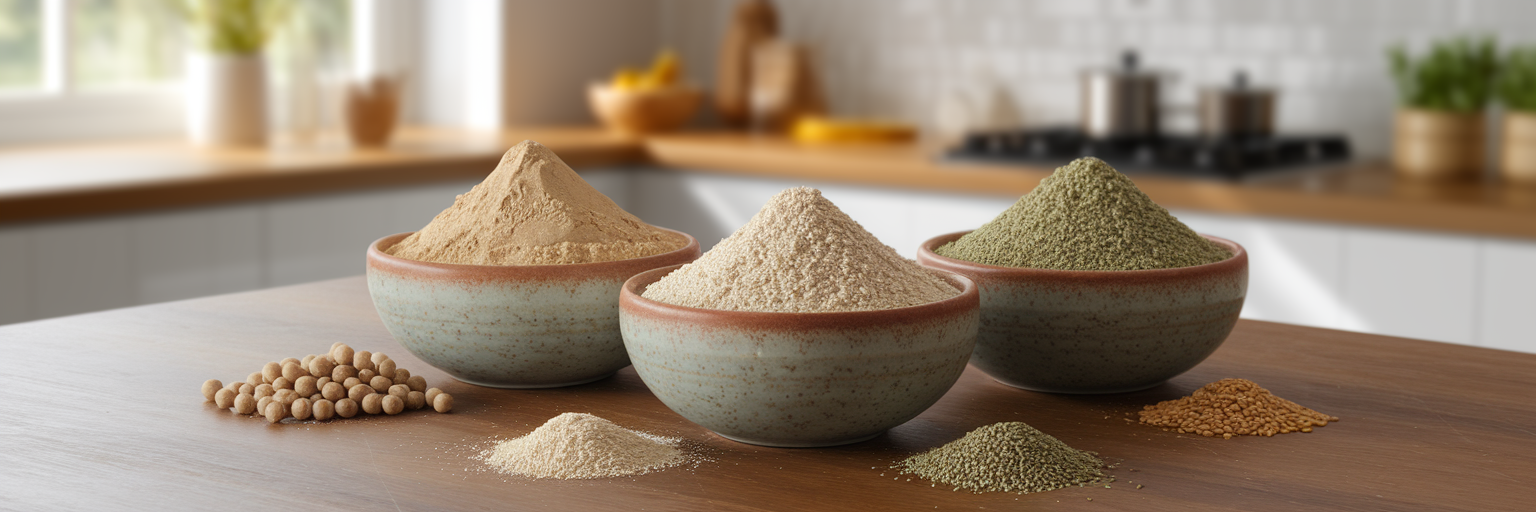Why Your Protein Shake Might Be Causing Discomfort
You finish a tough workout, mix up your protein shake, and then it hits: that frustrating, uncomfortable feeling of bloating or stomach upset. If this sounds familiar, you are definitely not alone. Many athletes struggle to find a vegan protein without bloating, and it can feel discouraging when something meant to help your recovery ends up causing discomfort.
Often, the protein itself isn't the only thing to blame. Many powders contain ingredients that can be tough on a sensitive system. Artificial sweeteners like sucralose, for instance, can be difficult for the gut to process. Sugar alcohols, such as erythritol and xylitol, are another common culprit. They can draw water into your intestine, which is a direct cause of that bloated, gassy feeling.
Then there are the thickeners and gums. Ingredients like xanthan gum are added to create a smoother, creamier texture, but for some people, they can ferment in the gut and lead to digestive issues. While these additives are common, it’s also true that certain plant protein sources can be harder to digest than others. This doesn't mean you have to give up on vegan protein. It just means you need to know what to look for. This guide will help you choose a powder that supports your performance and leaves your stomach feeling great.
Comparing the Top Hypoallergenic Protein Sources

Now that we've identified some common irritants, let's look at the protein sources themselves. Choosing the right base ingredient is the most important step toward finding the best hypoallergenic protein powder for your needs. Not all plant proteins are created equal when it comes to digestibility, and understanding the differences is key.
Pea Protein: The All-Around Performer
Pea protein has become incredibly popular for good reason. It’s derived from yellow split peas and is naturally hypoallergenic. More importantly, it boasts a complete amino acid profile, containing all nine essential amino acids your muscles need for repair and growth. It generally has a mild flavor and mixes into a smooth, creamy texture, making it a versatile and effective choice for athletes.
Rice Protein: The Gentle & Budget-Friendly Choice
Made from brown rice, this protein is known for being extremely gentle on the digestive system. If you have a particularly sensitive stomach, rice protein can be an excellent starting point. It’s also often more affordable than other options. The main consideration is that it's slightly lower in the amino acid lysine, which is why it’s frequently combined with other proteins.
Hemp Protein: The Fiber and Omega Powerhouse
When we compare pea protein vs hemp protein, hemp offers a unique set of benefits. It’s a complete protein that is also rich in fiber and healthy omega-3 fatty acids, both of which support good gut health. This added fiber can aid digestion for many people. However, it has a distinct, nutty flavor and can have a grittier texture, which might not be for everyone.
The Power of Blends: Getting the Best of All Worlds
You’ll notice many modern formulas use a blend of different protein sources. Combining pea and rice protein, for example, creates a robust, complete amino acid profile that rivals whey, while balancing out the texture and digestibility. These blends are often the most effective and palatable option, providing a high-quality, easy to digest vegan protein. Formulations like a well-crafted chocolate vegan protein often use this approach to ensure you get great results without sacrificing taste or comfort.
| Protein Source | Key Benefit for Digestion | Amino Acid Profile | Common Flavor/Texture |
|---|---|---|---|
| Pea Protein | Highly digestible and low in allergens | Complete (all 9 essential amino acids) | Mild, slightly earthy, and mixes smoothly |
| Rice Protein | Extremely gentle on the gut | Good, but lower in lysine | Slightly gritty if not finely milled, very mild flavor |
| Hemp Protein | Rich in fiber and omega-3s, which support gut health | Complete, but lower in some aminos | Distinctly nutty and earthy, can be gritty |
| Protein Blends | Combines sources to create a complete amino acid profile and balanced texture | Excellent and complete | Often the smoothest and best-tasting due to formulation |
Note: This table summarizes the general characteristics of each protein source. Individual product formulations can vary in texture and digestibility.
Decoding the Ingredient Label for a Happy Gut
Finding a gut friendly protein powder goes beyond the main protein source. The "other ingredients" list is where you can spot potential troublemakers or helpful additions. Think of yourself as a detective for your own digestive health. A shorter, cleaner ingredient list is almost always a better sign.
Here’s what to look for and what to avoid:
- Look for Digestive Aids: High-quality powders often include ingredients to help your body process the protein. Prebiotics, like inulin or acacia fiber, act as food for the good bacteria in your gut. Probiotics are the beneficial bacteria themselves. Both support a healthy gut microbiome.
- Seek Out Digestive Enzymes: Some formulas add enzymes like protease, which specifically helps break down protein. This can make a huge difference in absorption and reduce the chance of bloating. As highlighted in publications like Forbes, adding enzymes is a growing trend for improving protein powder digestibility.
- Choose Clean Sweeteners: Opt for natural, zero-calorie sweeteners like monk fruit or stevia. Be wary of artificial sweeteners like sucralose and aspartame, as well as sugar alcohols like erythritol or xylitol, which are common triggers for digestive distress.
- Avoid Gums and Fillers: Thickeners like xanthan gum, guar gum, or carrageenan are used to improve mouthfeel, but they can be major culprits for gas and bloating in sensitive individuals. If you see a long list of gums, it might be best to steer clear.
Learning to read labels empowers you to make the best choice for your body. To continue learning about clean ingredients and effective formulations, you can find more insights on our blog.
Flavor and Mixing Tips for Better Digestion

Even the best protein powder can cause issues if it’s not prepared well. How you mix and consume your shake can significantly impact how your stomach feels afterward. Here are a few simple tips to create a delicious and comfortable experience with your vegan protein for sensitive stomach.
- Go for Natural Flavors: Look for powders flavored with real ingredients like cocoa powder or vanilla bean instead of vague "natural flavors" or "artificial flavors." Your gut will thank you for the cleaner ingredients.
- Choose Your Liquid Wisely: Water is always a safe bet, but if you want a creamier shake, opt for an easy-to-digest plant milk. Unsweetened almond milk, oat milk, or coconut milk are excellent choices that are typically gentler on the stomach than dairy.
- Use a Blender, Not a Shaker: This is a big one. A shaker cup is convenient, but a blender breaks down the powder much more effectively. This creates a smoother, less gritty texture that is easier for your digestive system to handle, reducing the likelihood of clumps that can cause discomfort.
- Boost Your Shake with Gut-Friendly Foods: Add other ingredients to your shake to support digestion. A tablespoon of ground flaxseed adds fiber, a small piece of fresh ginger can help soothe the stomach, and a handful of spinach blends in easily for extra nutrients without affecting the taste.
Making your shake an enjoyable ritual is part of the process. For more creative ideas, check out these easy vegan protein recipes you'll actually crave.
Final Tips from the Experts
You're now equipped with the knowledge to choose a protein powder that works with your body, not against it. Finding the right easy to digest vegan protein is a personal journey, but a few final tips can help you get there faster and with more confidence.
- Start Small: When trying a new protein powder, don't go for a full serving right away. Begin with a half scoop to see how your body responds. This gives your system time to adjust and allows you to assess your tolerance without overwhelming it.
- Consider Your Timing: Gulping down a shake right before a workout or immediately after an intense session can sometimes be hard on a stomach that’s already under stress. Try waiting 30 to 60 minutes post-workout to give your digestive system a chance to settle.
- Listen to Your Body: This is the most important rule. Everyone's digestive system is unique. What works for one person might not work for you. Pay attention to the signals your body sends and don't be afraid to experiment until you find your perfect match.
The path to a happy gut is paved with mindful choices. By selecting a hypoallergenic protein source, reading labels carefully, and being smart about how you prepare your shake, you can finally get the recovery benefits you deserve without the discomfort.
Found a gut-friendly powder that works for you? Share your success in the comments below! Ready to find your perfect match? Explore our full collection of athlete-focused supplements.



